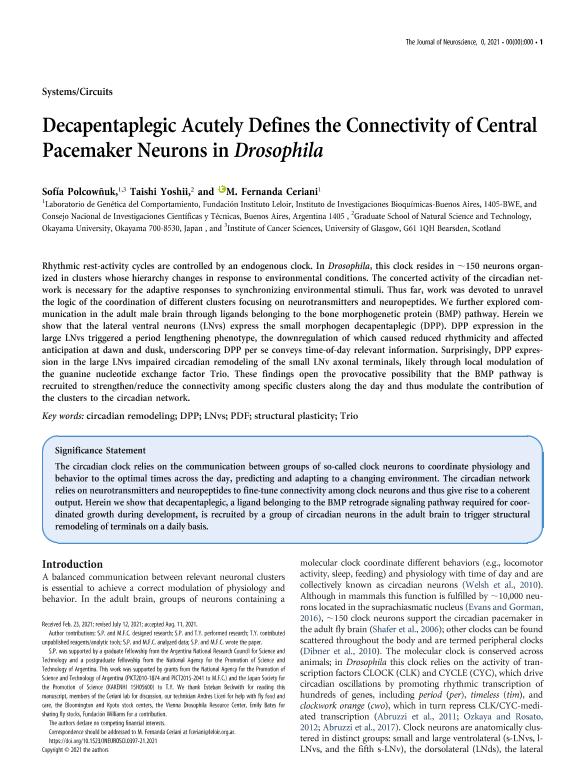Mostrar el registro sencillo del ítem
dc.contributor.author
Polcowñuk, Sofía

dc.contributor.author
Yoshii, Taishi
dc.contributor.author
Ceriani, Maria Fernanda

dc.date.available
2022-02-03T17:30:59Z
dc.date.issued
2021-08
dc.identifier.citation
Polcowñuk, Sofía; Yoshii, Taishi; Ceriani, Maria Fernanda; Decapentaplegic acutely defines the connectivity of central pacemaker neurons in drosophila; Society for Neuroscience; Journal of Neuroscience; 41; 41; 8-2021; 8338-8350
dc.identifier.issn
0270-6474
dc.identifier.uri
http://hdl.handle.net/11336/151293
dc.description.abstract
Rhythmic rest-activity cycles are controlled by an endogenous clock. In Drosophila, this clock resides in ;150 neurons organized in clusters whose hierarchy changes in response to environmental conditions. The concerted activity of the circadian network is necessary for the adaptive responses to synchronizing environmental stimuli. Thus far, work was devoted to unravel the logic of the coordination of different clusters focusing on neurotransmitters and neuropeptides. We further explored communication in the adult male brain through ligands belonging to the bone morphogenetic protein (BMP) pathway. Herein we show that the lateral ventral neurons (LNvs) express the small morphogen decapentaplegic (DPP). DPP expression in the large LNvs triggered a period lengthening phenotype, the downregulation of which caused reduced rhythmicity and affected anticipation at dawn and dusk, underscoring DPP per se conveys time-of-day relevant information. Surprisingly, DPP expression in the large LNvs impaired circadian remodeling of the small LNv axonal terminals, likely through local modulation of the guanine nucleotide exchange factor Trio. These findings open the provocative possibility that the BMP pathway is recruited to strengthen/reduce the connectivity among specific clusters along the day and thus modulate the contribution of the clusters to the circadian network.
dc.format
application/pdf
dc.language.iso
eng
dc.publisher
Society for Neuroscience

dc.rights
info:eu-repo/semantics/openAccess
dc.rights.uri
https://creativecommons.org/licenses/by-nc-sa/2.5/ar/
dc.subject
CIRCADIAN REMODELING
dc.subject
DPP
dc.subject
LNVS
dc.subject
PDF
dc.subject
STRUCTURAL PLASTICITY
dc.subject
TRIO
dc.subject.classification
Biología

dc.subject.classification
Ciencias Biológicas

dc.subject.classification
CIENCIAS NATURALES Y EXACTAS

dc.title
Decapentaplegic acutely defines the connectivity of central pacemaker neurons in drosophila
dc.type
info:eu-repo/semantics/article
dc.type
info:ar-repo/semantics/artículo
dc.type
info:eu-repo/semantics/publishedVersion
dc.date.updated
2022-01-27T18:14:18Z
dc.identifier.eissn
1529-2401
dc.journal.volume
41
dc.journal.number
41
dc.journal.pagination
8338-8350
dc.journal.pais
Estados Unidos

dc.journal.ciudad
Washington
dc.description.fil
Fil: Polcowñuk, Sofía. University of Glasgow; Reino Unido. Consejo Nacional de Investigaciones Científicas y Técnicas. Oficina de Coordinación Administrativa Parque Centenario. Instituto de Investigaciones Bioquímicas de Buenos Aires. Fundación Instituto Leloir. Instituto de Investigaciones Bioquímicas de Buenos Aires; Argentina
dc.description.fil
Fil: Yoshii, Taishi. Okayama University; Japón
dc.description.fil
Fil: Ceriani, Maria Fernanda. Consejo Nacional de Investigaciones Científicas y Técnicas. Oficina de Coordinación Administrativa Parque Centenario. Instituto de Investigaciones Bioquímicas de Buenos Aires. Fundación Instituto Leloir. Instituto de Investigaciones Bioquímicas de Buenos Aires; Argentina
dc.journal.title
Journal of Neuroscience

dc.relation.alternativeid
info:eu-repo/semantics/altIdentifier/url/https://www.jneurosci.org/content/41/40/8338
dc.relation.alternativeid
info:eu-repo/semantics/altIdentifier/doi/http://dx.doi.org/10.1523/JNEUROSCI.0397-21.2021
Archivos asociados
